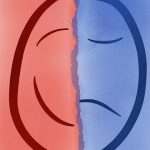What Is Bipolar Disorder Anyway?
Bipolar disorder is one of the less understood mental illnesses, since it is typically misdiagnosed and has a variety of different symptoms depending on which subtype the patient has. Typically bipolar, also known as manic depressive disorder, is characterized by extreme shifts in mood from manic to depressive; bi, meaning two, and polar, meaning opposite extremes. Though most normal functioning humans have mood swings every once in a while, the symptoms of bipolar disorder are much more extreme. These mood swings can last for days, weeks, or even months. When the levels of serotonin, dopamine, or norepinephrine – neurotransmitters in the brain linked to a person’s mood – are off, they can set off unexpected mood swings.
Mania is defined by feelings of extreme euphoria, creativity, and energy. Ever wonder why Beethoven and Van Gogh were so talented at what they did? It is speculated that they both suffered from bipolar disorder, which may have been the force behind many of their most famous works.
People suffering through a manic state tend to sleep very little, talk excessively, and feel as though they are invincible. Though it may seem as though they are on top of the world, manic episodes tend to spiral out of control – leading to excessive gambling, reckless sex, physical fights, and other bad decisions that can affect both relationships and careers. Extreme cases of mania can include symptoms of psychosis – seeing or hearing things that are not really there – which is why it can easily be misdiagnosed as schizophrenia. Living with someone with bipolar can be unsettling.
A subtype known as hypomania is a less severe form of mania. People experiencing hypomania may feel euphoric and energetic, though are able to continue with their daily lives without experiencing any extreme anger or feelings of invincibility.
Because of this, many people experiencing this, merely feel unusually happy and believe that everything is going well. Since most people dealing with hypomania don’t feel any negative symptoms, they don’t feel as though they need any treatment.
Unfortunately, many periods of hypomania are followed by mania or major depression.
The depressive side of bipolar is very similar to major depressive disorder, which is one of the reasons why it is so frequently misdiagnosed. Most commonly, bipolar depressive symptoms include guilt, feelings of restlessness, unpredictable mood swings, and irritability.
People suffering from bipolar depression tend to sleep a lot, gain weight, and have a generally sluggish demeanor. They experience such hopeless feelings that they sometimes lose contact with reality and are unable to work or interact with others. Normal depression symptoms are similar yet don’t always include all of the symptoms of bipolar depression.
Mixed episodes are characterized by symptoms of both mania and depression – and can also include the less intense hypomania. Common symptoms of a mixed episode are depression combined with anxiety, irritability, agitation, and racing thoughts. Because of the combination of increased energy and negative mood, those dealing with a mixed episode are at a higher risk of suicide.
There are three main types of bipolar disorder:
Bipolar I: This is the most intense form of bipolar, since the symptoms tend to be more severe. It is characterized mostly by intense episodes of mania, though commonly includes at least one episode of depression. People diagnosed with bipolar I are more likely to be hospitalized and experience psychosis during manic episodes.
Bipolar II: Characterized by hypomania (instead of the more intense mania) and at least one or more episodes of depression.
Bipolar II is typically misdiagnosed as major depressive disorder due to the patient feeling “normal” during periods of hypomania.
Cyclothymia: Also referred to as cycloclythmic disorder, it is a more mild form of bipolar which consists of recurring mood swings. This subtype is much less extreme than the main two types of bipolar, and moods vary between hypomania and mild depression.
In order to be diagnosed with cyclothymia, patients must experience these symptom for at least two years and not be symptom free for more than two consecutive months at a time.
Bipolar disorder affects both men and women equally – though bipolar II is more common in women – and can be hard to diagnose based on its similarity to other mental disorders. Many cases of this disorder occur between the ages of 15-25, and symptoms tend to worsen as time goes on without any treatment. In adults, episodes of mania or depression tend to last for weeks or even months. In children 
Though bipolar is a lifelong mental illness, understanding the different symptoms and getting a proper diagnosis is the first step to getting treatment. With patience and willpower, those diagnosed with bipolar disorder can live happy, healthy, normal lives.
From our hearts to yours,



